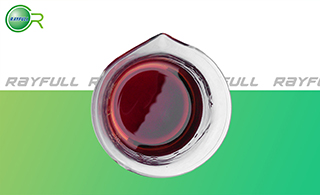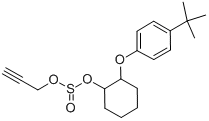Propargite
    ИІтэМШ ИІтэМШ
Introduction: Propargite is one kind of organic sulfuric acaricide, which is low poisonous, broad-spectrum, contact, and gastric effective, there is no interior absorption and osmotic conduction. It is specific for adult mite, nymph mite and young mite and is applied to prevent and cure the mites on crops such as cotton, vegetable, apple, orange and tangerine, tea, flower and plant, meanwhile, it is harmless to natural enemy.
Common name: Propargite
Another name: propargite; OMITE; Comite; 2-(4-(tert-Butyl)phenoxy)cyclohexyl prop-2-yn-1-yl sulfite; BPPS; Cyclosulfyne; Omait; Uniroyal D014; Omite 57E; etc.
Chemical name: 2-(4-tert-butylphenoxy)cyclohexyl prop-2-ynyl sulphite
Empirical formula: C19H26O4S
Structural formula:

Mol. Weight: 350.47 g/mol
CAS No.: 2312-35-8
Specifications
Leading Propargite supplier
Propargite 90% TC
Propargite 730 g/L EC
Propargite 570 g/L EC
Propargite 50% EC
Packing:
BULK PACKING
Powder: 25kg/Bag, 25kg/Drum, 50kg/Drum etc.
Liquid: 200L/Drum, 20L/Drum, 10L/Drum etc.
SMALL PACKING
Powder: 1kg/Alu bag, 500g/Alu bag, 200g/Alu bag, 100g/Alu bag, 50g/Alu bag, 15g/Alu bag etc.
Liquid: 5L/Drum, 1L/Bottle, 500ml/Bottle, 250ml/Bottle, 100ml/Bottle, 50ml/Bottle etc.
Customerized packing label
Propargite FAO standard
Professional registration
HAZARDS IDENTIFICATION
Hazard statement(s)
H315: Causes skin irritation.
H318: Causes serious eye damage.
H331: Toxic if inhaled.
H351: Suspected of causing cancer.
H400: Very toxic to aquatic life.
H410: Very toxic to aquatic life with long lasting effects.
Precautionary statement(s)
P201: Obtain special instructions before use.
P202: Do not handle until all safety precautions have been read and understood.
P261: Avoid breathing dust/fume/gas/mist/vapors/spray.
P264: Wash ... thoroughly after handling.
P271: Use only outdoors or in a well-ventilated area.
P273: Avoid release to the environment.
P280: Wear protective gloves/protective clothing/eye protection/face protection.
P281: Use personal protective equipment as required.
P302+P352: IF ON SKIN: wash with plenty of water.
P304+P340: IF INHALED: Remove victim to fresh air and keep at rest in a position comfortable for breathing.
P305+P351+P338: IF IN EYES: Rinse cautiously with water for several minutes. Remove contact lenses if present and easy to do - continue rinsing.
P308 +P313: IF exposed or concerned: Get medical advice/attention.
P310: Immediately call a POISON CENTER or doctor/physician.
P311: Call a POISON CENTER or doctor/...
P321: Specific treatment (see ... on this label).
P332 +P313: IF SKIN irritation occurs: Get medical advice/attention.
P362: Take off contaminated clothing.
P391: Collect spillage.
P403 + P233: Store in a well-ventilated place. Keep container tightly closed.
P405: Store locked up.
P501: Dispose of contents/container to.
Supplemental Hazard Statements: none.
MAMMALIAN TOXICOLOGY
Acute toxicity: 1) Acute oral LD50 for rats is 2639 mg/kg. 2) Acute dermal LD50 for rats is >4000 mg/kg. 3) Acute inhalation toxicity LC50 (4 h) for rats is 0.8 mg/l. 4) Skin irritation: Irritating to skin (rabbits). 5) Eye irritation: Irritating to eyes (rabbits). 6) Skin sensitization for guinea pig: Not a skin sensitiser.
NOEL: (2 y) for rats is 2.5 mg/kg/day, (2 y) for dogs is 15 mg/kg/day. Other Not genotoxic, not teratogenic.
ADI (JMPR) 0-0.01 mg/kg b.w. [1999]
Classification:
WHO Classification: III (Slightly hazardous)
EC Risk Classification: Carcinogen category 3: R40;T - Toxic: R23; Xn - Harmful: R41; Xi - Irritant: R38; N - Dangerous for the environment: R50, R53
US EPA Classification (formulation): III (Caution - Slightly toxic)
ECOTOXICOLOGY
Effect on birds: Acute oral LD50 for Mallard is >4640 mg/kg. Effect on fish: Acute LC50 (96 h) for Rainbow trout is 0.043 mg/l. Effects on aquatic invertebrates: Acute EC50 (48 h) for Daphnia magna is 0.014 mg/l. Effects on algae: Acute 72 hour EC50 for Scenedesmus capricornutum is >1.08 mg/l. Effects on bees: Contact acute (48 h) LD50 is 47.9 ҰМg/bee, Oral acute (48 h) LD50 is >100 ҰМg/bee. Effects on earthworms: Acute 14 day LC50 is 378 mg/kg.
ENVIRONMENTAL FATE
Animals In mammals, propargite is hydrolysed at the sulfite ester linkage to 1-[4-(1,1-dimethylethyl)phenoxy]-2-cyclohexanol and subsequent hydroxylation of the tert-butyl side-chain. Additional metabolites are formed by further oxidation or sulfation of the tert-butyl group and oxidation of the cyclohexyl moiety. Plants Although propargite is considered a non-systemic pesticide, a small portion of the applied dose penetrates the outside layer of the foliage and undergoes the same metabolism as is observed in animals. In most fruits (apples, citrus), propargite stays mainly on the surface and, to a lesser extent, in the peel; only trace residues are detected in the pulp. Soil/Environment DT50 40-67 d (aerobic soil, pH 6.0-6.9, o.c. 1.0-2.55%, 22-25 ºC). Log Koc 3.6-3.9; no leaching in aged column study or in field dissipation studies. DT50 in water-sediment studies 1.7-2.5 d (water phase), 18.3-22.5 d (whole system). Half-life in atmosphere 2.155 h (Atkinson calculation).
Usage: Propargite was introduced by Uniroyal Inc. (now Crompton Corp.). It control of many species of phytophagous mites (particularly motile stages) on a variety of crops, including vines, fruit trees (including top fruit, stone fruit, citrus fruit), hops, nuts, tomatoes, vegetables, ornamentals, cotton, maize, peanuts, and sorghum, etc.
Application: Biochemistry Inhibits mitochondrial ATPase, which results in interruption of normal mite metabolism and respiration. Mode of action Non-systemic acaricide with predominantly contact action; some additional action by inhalation. Uses Control of phytophagous mites (particularly motile stages) on a variety of crops, including vines, fruit trees (e.g. top fruit, stone fruit, citrus fruit), hops, nuts, tomatoes, vegetables, ornamentals, cotton, maize, peanuts, and sorghum. Used at rates from 0.75-1.8 kg/ha on row crops and foliar sprays of 0.85-3.0 kg/ha on perennial fruit and nut crops. Phytotoxicity Phytotoxic to pears, strawberries, roses, and cotton under 10 inches in height. Citrus fruit and beans may also show some injury.
| 






